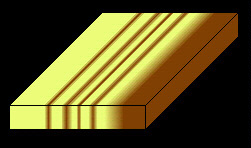
Disclaimer
All of the information on this page is based on my research, which has been aided by and based on others' work. I am not a professional geneticist, and as a result termonology may be used incorrectly. I have tried to limit the amount of termonology used as much as possible to things which are used in every-day vocabulary. Also, I am approaching the genetic aspect of color in P. bridgesii in a strictly observational, mostly Mendelian way. What I refer to as "genes" could just as well be called "factors" as Mendel refered to them.
Color Genes in Marisa cornaurietis
This is a species which I have only recently started to document, but so far the various traits and iheritance patterns have been amazingly clear compared to the complicated mess of Pomacea bridgesii genes. In Marisa, there is a clear set of genes which are limited to two forms (and as such can be considered like an "on/off switch"). The factors that affect the color include: two pigments in the shell (yellow & brown), the presence or lack of stripes, the underlying flesh color, and the body "spot" color. The dominance of these traits is as shown below:
| Color Trait forms in Marisa cornaurietis | |||||
| Pigment 1 | Pigment 2 | Stripes | Flesh Color | Body Spot Pattern | |
| Dominant | Yellow Present | Brown Present | Present | White | "Salt & Pepper" |
| Recessive | yellow abscent | brown abscent | abscent | lage black blotches | |
Although counterintuitive, the presence of stripes is not always linked to the presence of either yellow or brown pigment. If stripes are present, they will be expressed as heavily pigmented bands of whichever pigment is present. So, it is possible to get a gold Marisa cornaurietis with gold stripes, and a gold Marisa with brown stripes. Likewise it is also possible to have a Marisa with brown stripes and a white shell base (no yellow pigment). However, the expression of the brown pigment is linked to the presence of the stripes: if stripes are absent, there will be no brown pigment expressed anywhere even if the gene exists for its production. Based on the table above, it would in theory be possible to get ivory (all white) shelled Marisa cornaurietis, however that has yet to be tested through selective breeding. I am still researching that possibility through my own experiments. Possible combinations of the shell colors result in the following overall appearances:
| Shell Colors in Marisa Cornaurietis | |
 Wild type: yellow & brown pigment with stripes. Documented. |
 Unnamed: no yellow pigment, brown pigment with stripes. Documented. |
 Golden: yellow pigment with no stripes and no brown pigment expressed; may or may not have gene for brown pigment production. Documented. |
 Unnamed: no yellow pigment, no brown pigment, no stripes. Undocumented. |
 Striped Golden: no brown pigment, yellow pigment with stripes. Documented. |
 Unnamed: yellow & brown pigment with stripes. Lacks normal brown band on snail's left side (image's right side). Documented in 3 offspring of an unknown color cross - 30/May/2004. |
It is also possible that there could be a 3rd form of the body spot pattern of dense but still somewhat speckled black pigment that results in the overall appearance of a solid brown foot (with a white bottom of course, since no pigment occurs on the underside of the foot in any Apple Snail). I have not conclusively observed it to be different from the black-blotch form of the trait, but the presence or absence of white areas in the pigment seems to be inherited, suggesting that the solid-brown appearance is a unique version.
In addition to the possible presence of another spot pattern, there also seems to be a frequent abnormality (for lack of a better word) which causes large white stripes down the back side of the foot. This coloration is not inherited in a normal fasion, so for the moment I can only conclude that it is a mutation of some sort that deviates from the regular spot pattern trait forms. Also, the recessive form of the flesh color (if any) is not yet apparant.